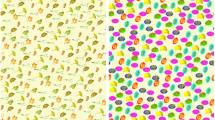Abstract
Despite the tremendous rendering power offered by modern GPUs, real-time and photo-realistic rendering is still often out of reach of traditional polygonal-based rendering. Thanks to the invention of texture mapping, a scene with a moderate number of triangles could be readily and vividly rendered by nowadays popular and inexpensive graphics cards. However, as a desired texture often comes with a very limited size, the technique of texture synthesis, i.e., synthesizing a larger texture from an originally smaller texture, has become a popular research topic in recent years. Numerous techniques have been proposed to successfully synthesizing 2D textures in terms of quality and performance. 3D or solid texture synthesis, on the other hand, remains relatively unexplored due to its higher complexity. There are several types of existing algorithms for solid texture synthesis, and among them, the outstanding work by Jagnow et al. [1] opens a new door for solid texture synthesis of discrete particles; however, their work did not address two important issues, thus leaving room for further improvement. First, without the help of stereology, users need to explicitly provide the 3D shapes of target particles for synthesis, and this is especially true when oftentimes only a 2D texture image is available for solid texture synthesis. Second, the locations and orientations of the 3D particles are resolved by a simulated annealing method, which is intrinsically a non-deterministic approach, and thus the optimality is not always guaranteed. To solve the shape problem, we propose a simple algorithm that applies the idea of visual hulls to approximate the shapes of 3D particles when only a 2D image is given; to solve the location and orientation problem, we design a deterministic algorithm that could place these desired 3D particles in space more properly. Most importantly, there is no need for user’s intervention for both algorithms. We have successfully implemented the proposed algorithm and the experimental results are also presented for comparisons with previous results and also for the proof of our concepts.
Preview
Unable to display preview. Download preview PDF.
Similar content being viewed by others
References
Jagnow, R., Dorsey, J., Rushmeier, H.: Stereological Techniques for Solid Textures. In: SIGGRAPH 2004, pp. 329–335 (2004)
Gardner, G.: Simulation of Natural Scene Using Textured Quadric Surfaces. In: SIGGRAPH 1984, pp. 11–20 (1984)
Peachey, D.: Solid Texturing on Complex Surfaces. In: SIGGRAPH 1985, pp. 279–286 (1985)
Perlin, K.: An Image Synthesizer. In: SIGGRAPH 1985, pp. 287–296 (1985)
Dischler, J., Ghazanfarpour, D.: A Survey of 3d Texturing. Computers & Graphics 25, 135–151 (2001)
Ghazanfarpour, D., Dischler, J.: Spectral Analysis for Automatic 3-d Texture Generation. Computers & Graphics 19, 413–422 (1995)
Ghazanfarpour, D., Dischler, J.: Generation of 3d Texture Using Multiple 2d Models Analysis. Computer Graphics Forum 15, 311–323 (1996)
Dischler, J., Ghazanfarpour, D., Freydier, R.: Anisotropic Solid Texture Synthesis Using Orthogonal 2d Views. Computer Graphics Forum 17, 87–96 (1998)
Chen, Y., Ip, H.H.: Texture Evolution: 3d Texture Synthesis from Single 2d Growable Texture Pattern. The Visual Computer 20, 650–664 (2004)
Wei, L.: Texture Synthesis from Multiple Sources. In: SIGGRAPH 2003 Sketches & Applications (2003)
Wei, L., Levoy, M.: Fast Texture Synthesis Using Tree-Structured Vector Quantization. In: SIGGRAPH 2000, pp. 479–488 (2000)
Heeger, D.J., Bergen, J.R.: Pyramid-Based Texture Analysis/Synthesis. In: SIGGRAPH 1995, pp. 229–238 (1995)
Dischler, J., Ghazanfarpour, D.: Interactive Image-Based Modeling of Macrostructured Textures. Computers & Graphics 19, 66–74 (1999)
Laurentini, A.: The Visual Hull Concept for Silhouette-Based Image Understanding. IEEE Transactions on Pattern Analysis and Machine Intelligence 16, 150–162 (1994)
Petitjean, S.: A Computational Geometric Approach to Visual Hulls. International Journal of Computational Geometry & Applications 8, 407–436 (1998)
Laurentini, A.: The Visual Hull of Curved Objects. In: ICCV 1999, pp. 356–361 (1999)
Voronoi, G.M.: Nouvelles Applications des Paramètres Continus à la Théorie des Formes Quadratiques. Premier Mémoire: Sur Quelques Propriétés des Formes Quadratiques Postives Parfaites. J. Reine Angew Math. 133, 97–178 (1907)
Voronoi, G.M.: Nouvelles Applications des Paramètres Continus à la Théorie des Formes Quadratiques. Deuxième Mémoire: Recherches sur les Parallélloèdres Primitifs. J. Reine Angew Math. 134, 198–287 (1908)
Berg, M.D., Kreveld, M.V., Overmars, M., Schwarzkopf, O.: Computational Geometry, Algorithms and Applications, 2nd edn. Springer, Heidelberg (2000)
Author information
Authors and Affiliations
Editor information
Editors and Affiliations
Rights and permissions
Copyright information
© 2006 Springer-Verlag Berlin Heidelberg
About this paper
Cite this paper
Chiou, JW., Yang, CK. (2006). A New Algorithm for Solid Texture Synthesis. In: Bebis, G., et al. Advances in Visual Computing. ISVC 2006. Lecture Notes in Computer Science, vol 4292. Springer, Berlin, Heidelberg. https://doi.org/10.1007/11919629_78
Download citation
DOI: https://doi.org/10.1007/11919629_78
Publisher Name: Springer, Berlin, Heidelberg
Print ISBN: 978-3-540-48626-8
Online ISBN: 978-3-540-48627-5
eBook Packages: Computer ScienceComputer Science (R0)




